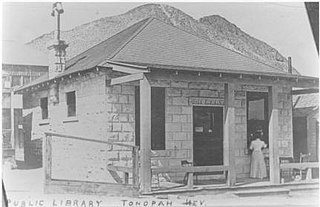
The Tonopah Public Library in Tonopah, Nevada was the third public library in Nevada.The one story stone building was designed by John J. Hill and was completed in 1906. The library was established by local residents Grace R. Moore and Marjorie Moore Brown to house a gift of 200 books from George F. Weeks.

The Brokers Exchange in Tonopah, Nevada, also known as the Tonopah Divide Mining Company was built in 1905 during Tonopah's mining boom. Originally a two-story building, it housed a brokerage, real estate office, and the offices of Tonopah lawyer Patrick McCarran. A fire destroyed the upper floor in 1912. The Tonopah Divide Mining Company, controlled by George Wingfield and Cal Brougher, purchased the property for use as an office in 1919. The ruined top story was removed and the first floor was re-roofed and capped with a decorate plaster frieze.
John James Hill (1853–1932), known as John J. Hill, was born in Leicester, England. He was a stonemason and builder in Utah and Nevada in the United States.
The Cal Shaw Adobe Duplex is an adobe house located at 129 Central Street in Tonopah, Nevada. The house, which was built in 1905, is typical of the adobe homes commonly built in Tonopah in the early 1900s. The building's exterior is scored to resemble stone; the home's design also features a decorative frieze and a porch supported by turned columns. The home has changed little since its construction and has been called "the best preserved adobe residence in Tonopah" by a local historic survey.
The Cal Shaw Stone Row House is a stone row house located on Central Street in Tonopah, Nevada, United States. Property owner Cal Shaw built the house in 1906 next to the Cal Shaw Adobe Duplex, which was built the previous year. While the house was built with stone instead of adobe, it features a similar design to the adobe house, particularly in its projecting roof and porch supported by columns. The house and its neighbor reflect the variety of homes built on Central Street, one of the earliest residential areas in Tonopah. In addition, the house's detailed and well-preserved design led a local historic survey to call it "one of the best preserved examples of stone residential construction in Tonopah".
The Combellack Adobe Row House is an adobe row house located on Central Street in Tonopah, Nevada. The Tonopah Extension Mining Company built the home in 1903 to house its employees. The house is the oldest adobe home in Tonopah; its walls were cast in place rather than built in blocks, as the former method was more efficient and more popular in the town. The home was part of one of Tonopah's first residential areas on Central Street, which was a well-developed district by 1904. J.M. Combellack, who had lived in the home since it was built, became its owner in 1905.

The Judge W. A. Sawle House is a historic house located at 151 Central Street in Tonopah, Nevada, United States. W. A. Sawle, the local Justice of the Peace, built the house for himself in 1904. The frame house was designed in a blend of the Late Victorian and Colonial Revival styles. The home has a "T"-shaped plan and features a verandah with a crooked shape and a balustrade, wooden jig-cut bracketing along the top of the verandah, and a hipped roof. While living in the house, Sawle became Nye County's recorder and auditor, helped establish Tonopah's first Justice Court building, fathered the first baby born in the city, and invested in the local mining business.
The Stone Jail Building and Row House are two adjacent stone buildings located on Water Street in Tonopah, Nevada. The jail was built in 1903 and the adjacent row house in 1908. Both building were at one time used as a brothel. The buildings were added to the National Register of Historic Places in 1982.
The Brann Boardinghouse is a historic boarding house located on Bryan Street in Tonopah, Nevada. The 2+1⁄2-story building is the largest wood-frame residence in Tonopah. The building's design includes a two-story porch with a balustrade along the second floor, molded cornices, boxed eaves, and a hipped roof; the inside has 18 rooms connected by two central hallways, one on each floor. Mrs. A.J. Brann built the boarding house in 1906. It was one of many boarding houses built in Tonopah to house the community's miners. The house is now one of only four boarding houses remaining in Tonopah.
The Cada C. Boak House, located on Ellis St. in Tonopah, Nevada, is a stone house that was built in 1906 by one A.P. Kanters. It was listed on the National Register of Historic Places in 1982.
The Zeb Kendall House, at 159 University Ave. in Tonopah, Nevada, United States, was built in 1906. It was listed on the National Register of Historic Places in 1982.

The Campbell and Kelly Building, at Corona and Main Sts. in Tonopah, Nevada, is a historic building built c. 1912. It was listed on the National Register of Historic Places in 1982.
The Dr. J. R. Masterson House, at Ohio Ave. and 2nd St. in Tonopah, Nevada, is a 35-by-35-foot stone and frame historic building that was built in 1908. It has also been known as the Fred Chapman House. It was built as a residence and later served as a rooming house for most of its existence. It was a work of James Golden. It was listed on the National Register of Historic Places in 1982.

The E. R. Shields House, at 351 St. Patrick in Tonopah, Nevada, United States, was built in 1904. It includes Late Victorian details in a largely "Neo-Colonial" design. It was listed on the National Register of Historic Places in 1982.
The Frank Golden Block, at Brougher and Main Sts. in Tonopah, Nevada is a historic building that was built in 1902. It was listed on the National Register of Historic Places in 1982.
The Arthur Raycraft House, on Booker St. in Tonopah, Nevada, United States, is a historic stone house that was built in 1906. It was listed on the National Register of Historic Places in 1982. It was deemed significant for its association with banker and businessman Arthur G. Raycraft, and for its substantial architecture.
The Hugh H. Brown House, near Tonopah, Nevada, United States, is a large adobe house that was built in 1906. It was listed on the National Register of Historic Places in 1982. It was deemed significant for its association with Tonopah attorney Hugh H. Brown.
The E. E. Burdick House, at 248 Prospect St. in Tonopah, Nevada, United States, was built in 1906. It has also been known as St. Marks P.E. Church Parsonage. It was listed on the National Register of Historic Places in 1982.

The Uri B. Curtis House, at 169 Booker St. in Tonopah, Nevada, United States, was built in 1906. It was listed on the National Register of Historic Places in 1982.
The Uri B. Curtis House–Tasker L. Oddie House, on Ellis St. in Tonopah, Nevada, United States, was built in 1902 and later enlarged. It is listed on the U.S. National Register of Historic Places. It was deemed significant for association with Tasker Lowndes Oddie, who was a lawyer and businessman and politician, eventually serving as governor of Nevada.








